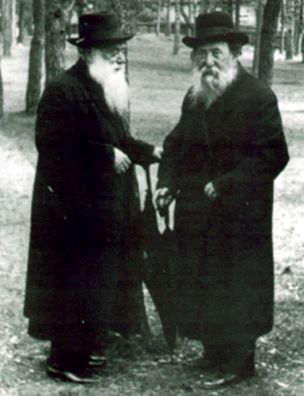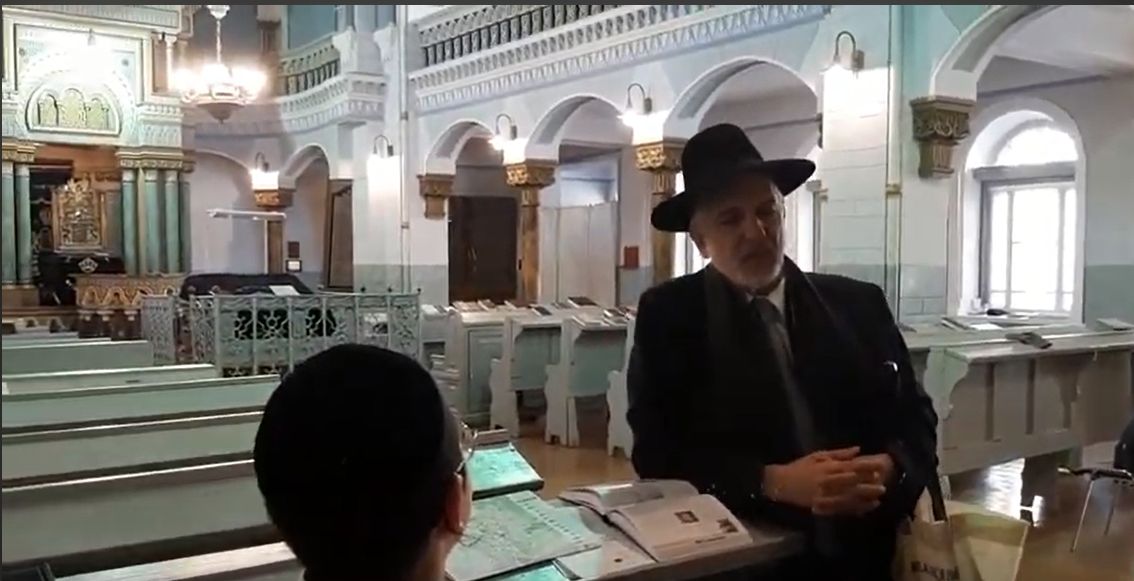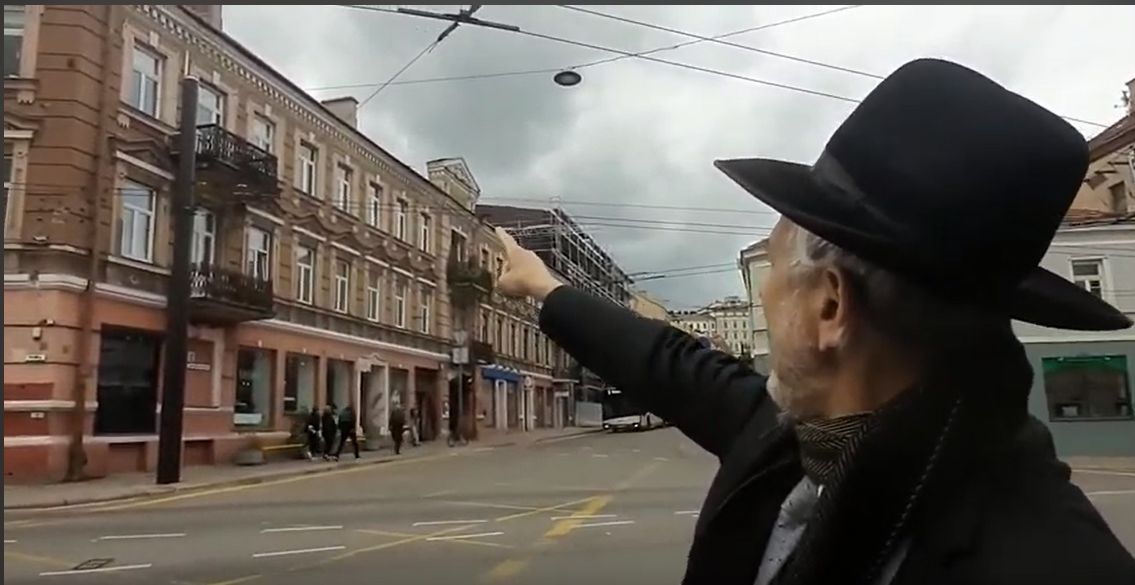HaRav Chaim Ozer and HaRav Shimon Shkop

This extended historical series about the battles over the rabbinate in Vilna was originally published in 1995 (5755).
For Part I of this series click here.
For Part III of this series click here.
Chapter Two: The Conflict
Yerushalayim DeLitta
Vilna—"The Gra's Vilna," as it was known. Vilna—the capital of Lithuania—was also a capital of Torah, yiras shomayim, kedusha and gemilus chesed. Vilna was a phenomenon unequaled anywhere else in the world: a city to which no other could compare. It was the city where gedolim of the stature of the Chelkas Mechokek served as rav; the city which Rabbi Akiva Eiger felt himself unequal to serve in that capacity; the city whose very streets and houses spoke Torah; the city where every facet of Torah greatness, in both learning and deeds, was to be found.
In Vilna, one could find ordinary, everyday Yidden who were fluent in absolutely every part of Torah. One could come across a tailor who would string together several sidrei mishnayos while he threaded his needle; a blacksmith, belonging to the blacksmith's shul, who used to give a shiur that was on a par with the shiur of the rosh yeshiva of the Ramailles Yeshiva in the neighboring courtyard. You could have seen an ordinary water carrier who had no need for a Vilna Shas because he knew it all by heart already and a plain shoe maker—as HaRav Chaim Ozer Grodzensky writes in his haskomo—who published a sefer entitled Shem Hagedolim Hashelishi, completing the great Chida's work of the same name.
In the first part we read about the background of Vilna and its rabbonus. We saw that the real position of Chief Rabbi of Vilna was left unfilled for more than a hundred years, until the secular authorities insisted on the appointment of a rav to administer the registration of demographic information such as births, deaths and weddings. The community was required to appoint such a "rav meitaam," and the choice came down to a test of strength between the traditional side led by HaRav Chaim Ozer and the reformers and maskilim. Before his election, Rav Rubinstein promised Reb Chaim Ozer that he would stay clear of any involvement in Vilna's communal institutions. Did he keep to his word? The following chapter provides the answer.
The Unholy Choice
The Zionists, Assimilationists and maskilim, as well as any other groups who a had good reason not to fall in with Reb Chaim Ozer's choice of candidate, convened an urgent meeting in the "enlightened," Beis Haknesses Taharas Hakodesh (which was truly untainted by anything holy). Amongst the participants was a woman—a sister of Dr. Chaim Weizmann who later became the first President of the State of Israel. Evidently there is nothing new in the Zionist tactic of including women in the bodies that elect rabbonim!
At this meeting they announced their nominee for rav of Vilna— Chaim Tschernowitz—an announcement that stunned everyone who still held dear Vilna and what the city stood for.
Chaim Tschernowitz was cut of precisely the right cloth for the Vilna maskilim. He was a maskil himself—this alone was enough reason for Reb Chaim Ozer to object—but besides, he already had a singularly sinister list of accomplishments to his name. Reb Chaim Ozer was very familiar with the past career of Tschernowitz—a most unorthodox career it had been too—and the name of "The Young Rav" (this was Tschernowitz' nom de plume) made him shudder.
"The Young Rav" started out on his secularist career as the rav of Odessa and he had done his fair share to earn for his city the ignominious observation that if the forty parsos around Vilna were perfumed with the fragrance of Torah, then the forty parsos that surrounded Odessa reeked of haskalah. Amongst his activities had been the establishment of a "yeshiva" that "boasted" of Chaim Nachman Bialik and Dr. Klausner as "roshei yeshiva."
Well too, Reb Chaim Ozer remembered Tschernowitz' articles that had appeared in the journal Hashelach. Tearing kriya would be too muted a reaction to the heretical ideas that flowed from Tschernowitz' pen. He had written in support of Bible Criticism and had challenged Chazal and their teachings. It had even been rumored that Tschernowitz was planning to move his "yeshiva" to Vilna, of all places—a step that had the same significance as plunging a sword into the grave of the Gra, in the old cemetery.
As of yet however, Reb Chaim Ozer had not found an alternative candidate and he was forced to negotiate. At a conference he held with the bareheaded representatives of "the other Vilna," he offered to accept any other candidate they put forward as long as they withdrew Tschernowitz.
"Anyone but Tschernowitz" would later become Reb Chaim Ozer's campaign slogan, but for the moment, it seemed that there was no alternative. Nobody else who possessed a certificate of graduation had been suggested. While the maskilim therefore rallied to Tschernowitz as the man who would "liberate" Vilna from the forces of "darkness," for Reb Chaim Ozer, the mere mention of the man's name evoked feelings of revulsion. The atmosphere grew more and more stormy as time went on.
Suddenly, a new name was on the lips of the Jews of Vilna: Rav Yitzchok Rubinstein. He was not known in Vilna, indeed he was not even a resident of the city. He was young—just thirty years old—and talented. An alumnus of the Slobodke yeshiva, he was then serving as rav of Genischisk in the faraway Crimea.
His name became involved in the Vilna rabbinate controversy almost by accident. He had come to Vilna to visit family. Since Vilna and Reb Chaim Ozer were virtually one and the same though, it was unthinkable not to pay a visit to the godol hador at the same time. He went to Reb Chaim Ozer's home and made himself known. Reb Chaim Ozer got to know him and when he heard that Rav Rubinstein possessed a graduation certificate, his eyes lit up. He proposed to Rav Rubinstein that he run for election as the government rav. His proposal was accepted.
Rav Elchonon Baron in the Taharas HaKodesh shul in Vilna (the only shul still functioning there)

Election Fever
The campaign got underway. There were many candidates: Heller, Schreiber and Rakovschik, to name a few of the "also rans." The main struggle though, was between the two men from the opposing camps: "The Young Rav," Tschernowitz, and Rabbi Yitzchok Rubinstein. Rav Rubinstein's popularity was negligible compared to Tschernowitz's. The former was, as of yet, an unknown—nobody even knew how he had come to be in Vilna—while the latter was known all across Russia. Tschernowitz had already been a public figure before Rav Rubinstein was born.
By the mizrach wall in Beis Haknesses Taharas Hakodesh, a seat had been prepared for the government "rav." All the candidates delivered speeches there in Russian and the tide seemed to be in Tschernowitz's favor. The famous secular historian Simon Dubnow (a pupil of the famous anti-religious German historian Graetz) issued a public statement that asked: "Why do the rabbonim oppose the election of C. Tschernowitz?" Almost all the Jewish newspapers supported the maskilim. They played their part in calling for the election of "The young rav with the young spirit."
Reb Chaim Ozer's home was the headquarters of the opposition. Since at that time, the chareidim had no suitable vehicle to convey their point of view to the public, the Vaad HaRabbonim, led by Reb Chaim Ozer, had to find alternative methods of publicity. They called all those who were eligible to vote to come to them and influenced them to vote for Rav Rubinstein, or at the very least, not to vote for Tschernowitz.
Their entreaties did not fall on deaf ears and in the Tschernowitz camp, they began to realize that the battle was all but lost already. They therefore decided to remove their objections to Rav Rubinstein's candidacy. They did this out of the fear that many would take note of their opposition to Rav Rubinstein, yet would not dare vote for Tschernowitz. The result of such a situation could be that a third candidate would take the rav's place in Taharas Hakodesh.
Rav Elchonon Baron pointing out the home of HaRav Chaim Ozer in Vilna

The elections took place on the 18th of January 1910. The previous day, Reb Chaim Ozer had invited Rav Rubinstein to his house and had spoken with him at length. He had requested that, in the event of Rav Rubinstein's winning the election, he refrain from mixing into the affairs of the rabbinate and remain solely within the confines of his official position. He could register as many births, marriages and deaths as he wished as long as he didn't overstep his job's boundary.
Rav Rubinstein, as of yet unelected, gave the required undertaking, promising that he would keep out of the affairs of the community and the rabbinate, leaving them in the charge of Reb Chaim Ozer—Vilna's uncrowned rav.
The next morning saw all the voters going off to vote. The Vilna regulations allowed every beis haknesses that was frequented by over a hundred members, to choose ten of them who would then be given the vote. These preliminaries had been carried out long before all the candidate's names were publicized. Ten percent of Vilna's batei knesses and batei medrash had over a hundred mispallelim so there were 1040 voters, 1039 of whom voted. That night, when the votes were counted, it was clear that the chareidim were victorious.
Fifty-eight percent supported Rav Rubinstein while only thirty-eight percent voted for Tschernowitz. According to one aged native of Vilna, the crushing defeat suffered by the maskilim was the talk of the city. Tschernowitz's supporters were furious and for a long time, they wouldn't exchange a single word with Rav Rubinstein. For his part, the latter assumed his new position, taking the seat that had been prepared for him in Beis Haknesses Taharas Hakodesh — and Vilna's chareidim rejoiced.
Nobody was aware of the future consequences of the successful election campaign. Rav Avrohom Rein of Petach Tikva, a member of the city council for Aguda Yisroel and a leader of the Tzeirei Agudas Yisroel Movement, told me something he heard from HaRav Yaakov Yisroel Lubschansky, the mashgiach of Baranovitch and the son-in-law of the Alter of Novorhodok. Reb Chaim Ozer had travelled to Petersburg in his efforts to bring about Tschernowitz's defeat. On his way back to Vilna, he passed through Brisk and stopped off to speak with Reb Chaim Soloveitchik.
"You just can't tell," said Reb Chaim Brisker, "what the end could be with this Rubinstein..."
The Tables Are Turned
As Rosh Hashanah 5689 (1928) approached, the Jewish community of Vilna was embroiled in another bitter dispute. In nearby Radin, the Chofetz Chaim — who was already over ninety years old — sent letters and protests to the chareidi newspapers. The theme of all his communications was "Elbonah Shel Torah" — "The Torah Disgraced."
The Chofetz Chaim was the guiding spirit behind the activities of the Vilna "Action Committee," that was composed of the city's gedolei Torah and the rabbonim of the surrounding suburbs. Behind the scenes, Rav Avrohom Yeshayohu Karelitz, the Chazon Ish, was in control of operations, directing the actions of his disciples and followers. Vilna itself was seething. Its newspapers waged a bitter war for over a year and the ultimate result was a crushing defeat for chareidi Jewry although the other side did not emerge unscathed.
The only apparent thing in common between this controversy and its predecessor in 5670 (1910) was that both of them centered on the question of the city's rabbinate. Otherwise, there seemed to be little connection. While originally the question had merely involved the appointment of an official government rav, the issue at stake now was the rabbonus itself — an entirely different matter. The whole Jewish world became involved in an issue that had weighty practical ramifications for all chareidim.
It was already not a question of a chareidi majority against a secular minority (58% to 38% — to recall the results of the election in 1910). This time, a small band of bnei Torah — and only bnei Torah — fought against a large and distinguished majority — the majority that ultimately prevailed. This time, Reb Chaim Ozer was not leading the campaign as he had done twenty years before. The Chofetz Chaim — the undisputed leader of faithful Jewry — guided Vilna's young rabbonim who travelled to consult with him about every step they took.
In fact, a search for comparisons is fruitless for the two episodes were entirely different from each other. The one and only true connection that can be made is Reb Chaim Brisker's observation, made twenty years earlier during the campaigning which preceded the 1910 election: "You just can't tell what the end could be with this Rubinstein..."
Victims Of The Great War
It was barely four years since the election that had restored peace and tranquility to the embattled Jewish community of Vilna that had almost been torn in two by the rival factions: the old, chareidi Vilna, that wanted to see Torah reign supreme over Jewish communal life, and the secular Vilna of the enlightenment, that wanted an irreligious lifestyle to prevail. It was barely four years since the election that had brought Rabbi Yitzchok Rubinstein in as the government rav, to the relief of the former faction and the chagrin of the latter, when the city was shaken once again — this time, together with the rest of the world.
The Great War broke out — the war that would be assigned its sequential number only thirty years later when war again broke out — the First World War. It was a war that uprooted the populations of cities and destroyed whole towns, a war that sent streams of refugees wandering in all directions, in hunger and thirst, carrying their families and little children with them. The Hebrew acronym for the year 5674 — taf-reish-ayin-dalet — spells the word "tir'ad," meaning "shook," as in vatir'ad ho'oretz, the earth shook.
No matter who is the victor in a war, the Jews are always losers. This was the tragic case all over Europe in the First World War and Vilna was no exception. The city changed hands several times as, one by one, Lithuania, Russia, Poland and Germany annexed it to their own territories. After the War, it remained in the hands of Poland. When war broke out, the conquering Russian powers belonging to Czar Nikolai Nikolayevitch, issued warrants of arrest for the two leaders of Jewish Vilna: Reb Chaim Ozer, the head of the Vaad HaRabbonim, and Rabbi Rubinstein, the government rav who represented political power in the Jewish community.
A high ranking Russian officer revealed the existence of the warrant to the heads of the Jewish community and Reb Chaim Ozer managed to escape, although not before the Chofetz Chaim — who, together with his yeshiva, also took up the staff of the eternal Jewish wanderer and went into exile deep into the Russian interior — had pressured him to do so. Reb Chaim Ozer himself had felt that he should stay on the Vilna battlefield and not desert the city's Jews. Even the danger to his own life that would be a very real one if he chose to stay, could not dissuade him from doing so, and he would not have left had it not been for pressure brought to bear on him by the Chofetz Chaim.
In the end, he left Vilna — not without some distress — and travelled into Russia, to Memel. Rabbi Rubinstein, on the other hand, for various reasons did not manage to get away and remained behind in hiding, in Vilna.
During the years that Reb Chaim Ozer was exiled from Vilna, Rabbi Rubinstein broke the promise he made to Reb Chaim Ozer before the 1910 election, that he would not seek to have a hand in the running of the communal institutions. Now, in Reb Chain Ozer's absence and aided by secular communal figures, he infiltrated and took over most of the community's institutions. Later on, in a carefully planned series of moves, he was appointed by the community as rav and more horo'oh and he was made a full member of Vilna's Vaad HaRabbonim. As of yet though, he was still only another rav in Vilna.
When Reb Chaim Ozer returned, he was faced with a fait accompli. The takeover was an established fact and there was nothing to be done about it. Most of the communal institutions were now under the control of Rabbi Rubinstein, the government rav — the "golem" who had risen against his creator. Vilna's chareidim were forced to come to terms with the new situation and carry on with life as usual. Although life in Vilna seemed to have returned to normal, things had significantly changed from the way they had been before.
Now that the rift between Reb Chaim Ozer and Rabbi Rubinstein had deepened, a meeting of a Vilna branch of the Mizrachi Movement took place, at the beginning of 5680 (1919). About two months later, a meeting of rabbonim was convened to launch the Agudas Yisroel of Vilna. Rabbi Rubinstein was present at the first meeting and, of course, Reb Chaim Ozer was at the second. The ideological gap between the two rabbonim rendered Rav Rubinstein's control of the institutions positively dangerous but there was nothing to be done.
End of Part II




